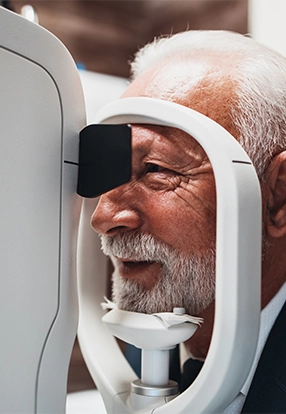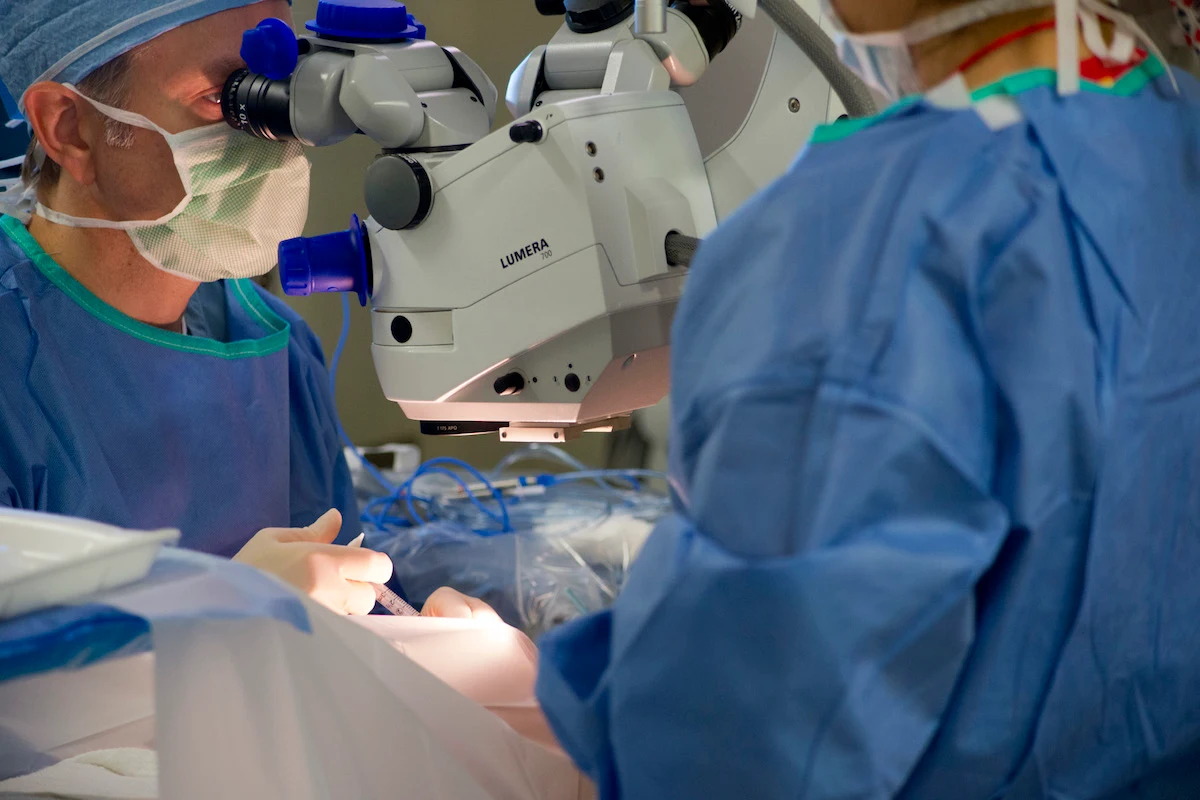Light Adjustable Lens™

 The Light Adjustable Lens (LAL) represents a breakthrough in cataract and refractive lens exchange surgery, offering a level of customization that was previously impossible with traditional intraocular lenses. At Diagnostic Eye Center in Houston, TX, our goal is to provide our patients with the most advanced vision correction options available, and the LAL allows us to do just that. By enabling post-surgical adjustments, the LAL provides patients with a highly personalized vision correction experience, reducing or even eliminating the need for glasses or contact lenses after cataract surgery. Whether you’re seeking to improve near vision, distance vision, or both, the Light Adjustable Lens can help you achieve your ideal visual outcome.
The Light Adjustable Lens (LAL) represents a breakthrough in cataract and refractive lens exchange surgery, offering a level of customization that was previously impossible with traditional intraocular lenses. At Diagnostic Eye Center in Houston, TX, our goal is to provide our patients with the most advanced vision correction options available, and the LAL allows us to do just that. By enabling post-surgical adjustments, the LAL provides patients with a highly personalized vision correction experience, reducing or even eliminating the need for glasses or contact lenses after cataract surgery. Whether you’re seeking to improve near vision, distance vision, or both, the Light Adjustable Lens can help you achieve your ideal visual outcome.
- What is the Light Adjustable Lens?
- How Does the Light Adjustable Lens Work?
- Benefits of the Light Adjustable Lens
- Preparing for Surgery With the LAL
- Cataract Surgery With the Light Adjustable Lens
- Recovery After Cataract Surgery with the LAL
- Light Adjustable Lens Customization
- FAQs About the Light Adjustable Lens
What is the Light Adjustable Lens?
The Light Adjustable Lens (LAL) by RxSight® is an advanced type of intraocular lens (IOL) that is revolutionizing cataract and refractive lens exchange procedures. Unlike traditional lens implants, which are fixed in strength once implanted, the LAL is the first and only FDA-approved lens that can be precisely adjusted after surgery. This unique capability offers patients a truly personalized vision correction experience.
Made from a specialized material that responds to UV light, the LAL allows for fine-tuning of vision even after the lens is already in place. Once the cloudy natural lens of the eye is removed during cataract surgery, the LAL is implanted to restore clear vision. Following surgery, the LAL can be adjusted using ultraviolet (UV) light treatments, allowing us to achieve the best possible outcome for each patient.
This means that patients who choose the Light Adjustable Lens have a greater chance of reaching their desired vision goals. Studies have shown that twice as many patients achieve
Trusted Source
Summary of Safety and Effectiveness (SSED) of Light Adjustable Lens and Light Delivery Device system
US Food and Drug Administration
Go to Source
20/20 vision
with the LAL compared to those who receive a standard IOL. This customized adjustment process significantly reduces or even eliminates the need for glasses or contact lenses after surgery.

How Does the Light Adjustable Lens Work?
Unlike traditional intraocular lenses that come with a fixed prescription, the Light Adjustable Lens (LAL) is the only lens that offers an extraordinary level of flexibility by allowing customization even after surgery. The LAL is made from a specialized photosensitive material, enabling it to change shape in response to UV light.
After cataract or refractive lens exchange surgery, and once the initial healing process is complete, patients return to our office for a series of light treatments with their eye doctor. During these sessions, a Light Delivery Device (LDD) is used to precisely expose the LAL to specific patterns of UV light. This controlled exposure adjusts the curvature of the lens, providing tailored vision correction. Once the ideal visual outcome is reached, a final UV light treatment is performed to “lock in” the prescription, ensuring lasting clarity. This unique process allows patients to experience a level of precision in vision correction that is not possible with
Trusted Source
Adjustable IOL Could Help Some Ditch Their Glasses After Cataract Surgery
American Academy of Ophthalmology
Go to Source
standard IOLs.
The Light Adjustable Lens (LAL) offers numerous benefits that set it apart from traditional intraocular lenses:
- Customizable Vision Correction: The LAL is the only intraocular lens that can be adjusted after it is implanted, providing a truly personalized vision correction experience. This allows adjustments to be made based on how the patient’s eyes respond to surgery, leading to more tailored results.
- Enhanced Precision: By fine-tuning the lens power after surgery, the LAL allows for a high level of accuracy in vision correction, significantly reducing the risk of refractive errors and improving the overall quality of vision.
- Reduced Dependence on Eyewear: Many patients are able to reduce or even eliminate their need for glasses or contact lenses after cataract or refractive lens exchange surgery, thanks to the LAL’s adjustable technology.
- Fast and Comfortable Adjustments: The customization sessions with the LAL are quick, safe, and non-invasive. Using specialized light treatments, adjustments can be made in a comfortable office setting without the need for further surgical procedures.
- Ideal for Previous Refractive Surgery Patients: The LAL is an excellent choice for patients who have previously undergone LASIK, PRK, or RK surgery. Unlike many other IOLs, which may not be compatible with corneal changes from prior laser surgeries, the LAL can
Trusted Source Refractive results after implantation of a light-adjustable intraocular lens in postrefractive surgery cataract patients Brierley L Go to Source adapt effectively, offering the best possible outcomes for these patients.

"I had a great experience with Dr. Salem giving me all the information and options for the cataract surgery he performed for me. They keep in constant contact pre and post surgery to make sure the entire experience was pleasant and to answer any and all questions. 100% satisfied! ONLY place I'd recommend!"

Preparing for Cataract Surgery with the LAL
Preparing for cataract surgery with the Light Adjustable Lens (LAL) begins with a consultation at Diagnostic Eye Center. During this initial appointment, one of our experienced ophthalmologists will conduct a thorough eye examination, confirm your cataract diagnosis, and review your medical history. This consultation is also an opportunity to discuss your vision goals and explore the different intraocular lens options available, including the LAL.
If the LAL is the right choice for you, your cataract surgeon will provide you with detailed pre-surgery instructions to ensure you are fully prepared. This includes guidelines on any medications to avoid before surgery and any other specific preparations needed for a smooth procedure. Additionally, it’s important to arrange transportation, as you will not be able to drive yourself home following the surgery. With careful planning and guidance from your eye care team, you can be confident in a successful experience with the Light Adjustable Lens.


Cataract Surgery With the Light Adjustable Lens
Cataract surgery with the Light Adjustable Lens (LAL) is a quick, outpatient procedure performed at a surgery center. The entire process takes about 10 to 15 minutes per eye, and patients remain comfortable with mild sedation and numbing eye drops.
A small incision is made in the front of the eye, often using a femtosecond laser for added precision. The clouded natural lens is then broken apart and removed through a process called phacoemulsification, and the LAL is inserted in its place. The small incision typically seals on its own, so no sutures are needed.
After surgery, patients rest briefly before heading home, and it’s essential to arrange for someone to drive you. With the LAL, you can expect a straightforward procedure and the opportunity for customized vision correction after recovery.
Recovery After Cataract Surgery with the LAL
Recovery after cataract surgery with the Light Adjustable Lens (LAL) involves a few additional steps compared to traditional intraocular lenses. Immediately following the surgery, you will be given an eye shield to protect the eye while it heals, which should be worn when sleeping or resting. You will also need to use antibiotic and anti-inflammatory eye drops for approximately four weeks.
A key difference in recovery with the LAL is the need to wear special UV-blocking glasses at all times during the first few weeks. These glasses protect the lens from unintended UV exposure until you have completed your post-surgical light treatments, which allow your ophthalmologist to adjust and fine-tune your vision, ensuring optimal results. Once the final light treatment is completed and your prescription is “locked in,” you can stop wearing the special glasses.
Avoid strenuous activity for about a week after surgery, but most patients find they can return to normal daily activities, including desk work, as soon as the day after their procedure.

Light Adjustable Lens Customization
After your eyes have healed from the initial cataract surgery, you will return to Diagnostic Eye Center to begin the Light Adjustable Lens (LAL) customization process. These adjustment sessions are quick, comfortable, and completely non-invasive. Customization treatments typically last less than two minutes each, though you should expect to spend about an hour in total during each visit.
During each appointment, your vision will be evaluated, your eyes will be dilated, and a specialized Light Delivery Device (LDD) will be used to expose the LAL to a specific wavelength of UV light. This light gently alters the shape of the lens, allowing for precise adjustments to fine-tune your vision. Because both eyes are treated, you may need to arrange transportation for each visit, as some patients feel uncomfortable driving afterwards.
Most patients require between three to four light treatments, spaced about three to seven days apart, to achieve the optimal vision outcome. This customization process gives you the opportunity to “test drive” your vision, ensuring the final results align with your preferences. Once the ideal vision is achieved, a final light treatment is performed to “lock in” your prescription, providing lasting visual clarity. After this point, UV-blocking glasses are no longer needed, and you can enjoy the full benefits of your new vision.
FAQs About the Light Adjustable Lens
If you want to reduce your dependence on eyeglasses or contact lenses after cataract surgery or refractive lens exchange, the Light Adjustable Lens (LAL) may be an excellent choice for you. This adjustable intraocular lens offers the unique ability to improve both near and distance vision, even for those with presbyopia or astigmatism. It is also well-suited for patients who have previously undergone refractive surgeries like LASIK, PRK, or RK, as it allows for precise adjustments that can address the unique characteristics of eyes that have undergone these procedures.
However, not everyone is a good candidate for the LAL. You may not be eligible if you have a history of retinal issues, certain eye infections, or if you are taking medications that cause UV sensitivity. During your consultation, your eye doctor will assess your overall eye health and medical history to determine if the LAL is the right fit for your needs and vision goals.
Yes, the Light Adjustable Lens is FDA-approved and considered both safe and effective. However, as with any surgery, there are some risks involved. The main precaution with the LAL is avoiding unintended UV exposure before the final prescription is locked in, which is why wearing the UV-protective glasses as instructed is crucial. Your eye doctor will go over all potential risks before the procedure.
Our patients do not report pain during the LAL customization process. During each session, numbing eye drops will be used to ensure you remain comfortable throughout the procedure. Some patients may feel slight pressure, but this sensation is typically brief and mild.
Most patients require between three to four light adjustment sessions, spaced about three to seven days apart, to achieve the best possible visual outcome. These sessions are quick and non-invasive, taking only a few minutes each.
Yes, it is critical to wear the UV-protective glasses during the recovery period until your lens prescription is finalized. The Light Adjustable Lens is sensitive to UV light, and unintentional exposure before the lens is “locked in” can alter your results. Once your final light treatment is completed, you can stop wearing the glasses.
The UV light treatments used to adjust the LAL are straightforward, non-invasive, and take only a few minutes. A specialized Light Delivery Device (LDD) is used to emit a specific wavelength of UV light, which allows your doctor to precisely adjust the power of the lens to fine-tune your vision. These adjustments continue until the desired vision is achieved, after which a final light treatment locks in your prescription.
Contact Us
If you’re interested in learning more about the Light Adjustable Lens or wish to schedule a consultation, contact Diagnostic Eye Center in Houston, TX today. Our experienced team is here to help you achieve the clear, customized vision you deserve.
1 US Food and Drug Administration. Summary of Safety and Effectiveness (SSED) of Light Adjustable Lens and Light Delivery Device system. Available: https://www.accessdata.fda.gov/cdrh_docs/pdf16/P160055B.pdf. Accessed September 30, 2024.
2 American Academy of Ophthalmology. Adjustable IOL Could Help Some Ditch Their Glasses After Cataract Surgery. Available: https://www.aao.org/eye-health/news/new-iol-adjustable-after-cataract-surgery?gclid=EAIaIQobChMI8NHr27nw6AIVSx-tBh0pRg6kEAMYASAAEgIzE_D_BwE. Accessed September 30, 2024.
3 Brierley L. Refractive results after implantation of a light-adjustable intraocular lens in postrefractive surgery cataract patients. Ophthalmology. 2013 Oct;120(10):1968-72. doi: 10.1016/j.ophtha.2013.03.010. Epub 2013 May 21. PMID: 23706698. Available: https://pubmed.ncbi.nlm.nih.gov/23706698/. Accessed September 30, 2024.
The doctors at Diagnostic Eye Center have reviewed and approved this content.
